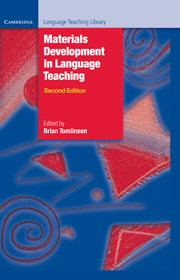Book contents
- Frontmatter
- Contents
- Preface
- Glossary of basic terms for materials development in language teaching
- Acknowledgements
- 1 Introduction: principles and procedures of materials development
- Part A Data collection and materials development
- 2 Using corpora in the language classroom
- 3 Concordances in the classroom without a computer: assembling and exploiting concordances of common words
- 4 Telling tails: grammar, the spoken language and materials development
- Comments on Part A
- Part B The process of materials writing
- 5 A framework for materials writing
- 6 Writing course materials for the world: a great compromise
- 7 How writers write: testimony from authors
- Comments on Part B
- Part C The process of materials evaluation
- 8 The analysis of language teaching materials: inside the Trojan Horse
- 9 Macro- and micro-evaluations of task-based teaching
- 10 What do teachers really want from coursebooks?
- 11 The process of evaluation: a publisher’s view
- Comments on Part C
- Part D The electronic delivery of materials
- 12 Developing language-learning materials with technology
- 13 New technologies to support language learning
- Comments on Part D
- Part E Ideas for materials development
- 14 Seeing what they mean: helping L2 readers to visualise
- 15 Squaring the circle – reconciling materials as constraint with materials as empowerment
- 16 Lozanov and the teaching text
- 17 Access-self materials
- Comments on Part E
- Conclusions
- Recommended reading
- Index
13 - New technologies to support language learning
Published online by Cambridge University Press: 09 February 2023
- Frontmatter
- Contents
- Preface
- Glossary of basic terms for materials development in language teaching
- Acknowledgements
- 1 Introduction: principles and procedures of materials development
- Part A Data collection and materials development
- 2 Using corpora in the language classroom
- 3 Concordances in the classroom without a computer: assembling and exploiting concordances of common words
- 4 Telling tails: grammar, the spoken language and materials development
- Comments on Part A
- Part B The process of materials writing
- 5 A framework for materials writing
- 6 Writing course materials for the world: a great compromise
- 7 How writers write: testimony from authors
- Comments on Part B
- Part C The process of materials evaluation
- 8 The analysis of language teaching materials: inside the Trojan Horse
- 9 Macro- and micro-evaluations of task-based teaching
- 10 What do teachers really want from coursebooks?
- 11 The process of evaluation: a publisher’s view
- Comments on Part C
- Part D The electronic delivery of materials
- 12 Developing language-learning materials with technology
- 13 New technologies to support language learning
- Comments on Part D
- Part E Ideas for materials development
- 14 Seeing what they mean: helping L2 readers to visualise
- 15 Squaring the circle – reconciling materials as constraint with materials as empowerment
- 16 Lozanov and the teaching text
- 17 Access-self materials
- Comments on Part E
- Conclusions
- Recommended reading
- Index
Summary
Introduction
Language classrooms have always used technologies of various kinds, from the blackboard through to the language laboratory. In recent decades, however, there has been an explosion in the resources available to teachers, to the point where many feel overwhelmed. This chapter, therefore, does not attempt to provide a comprehensive review of ‘state of the art’ technologies – primarily because the ground is shifting so rapidly that any such endeavour would soon be out of date. Rather, we have kept in mind an audience who are not necessarily interested in the finer points of technological innovations but who are seeking some practical input on those advances that are productive in fostering their students’ learning.
When it comes to electronic learning materials, we need to take into account the hardware, the software and the actual content such resources make available and the methodologies they promote. Ultimately, however, we are concerned with the quality of learning that these resources facilitate and the extent to which their use refl ects sound learning theory:
• is the input relevant, accurate, accessible and yet rich?
• what kinds of interaction are encouraged?
• what degree of support is provided and how are learners encouraged towards greater autonomy?
• how is useful feedback provided?
• is motivation stimulated?
Blake ( 2008 ) describes the successful technology-enhanced FL curriculum as student-centred, carefully planned, technically well supported and, most importantly, pedagogically well constructed.
In this chapter we will look at how teaching the macroskills (listening, speaking, reading and writing) might be enhanced through the incorporation of various digital materials. At each point we provide concrete examples of resources to illustrate the use of new technologies in language learning which classroom teachers have found to be useful in supporting their students’ language development. In concluding, we consider various pedagogical implications and speculate about future developments.
In exploring the role of the various technologies in learning, we have found it useful to think of language use along a continuum from ‘most spoken’ (oral interaction where language accompanies some activity in a shared physical environment) through to ‘most written’ (where texts need to be able to be understood by others who might be distant in time and space, independent of any shared experience).
- Type
- Chapter
- Information
- Materials Development in Language Teaching , pp. 328 - 351Publisher: Cambridge University PressPrint publication year: 2011
- 9
- Cited by



